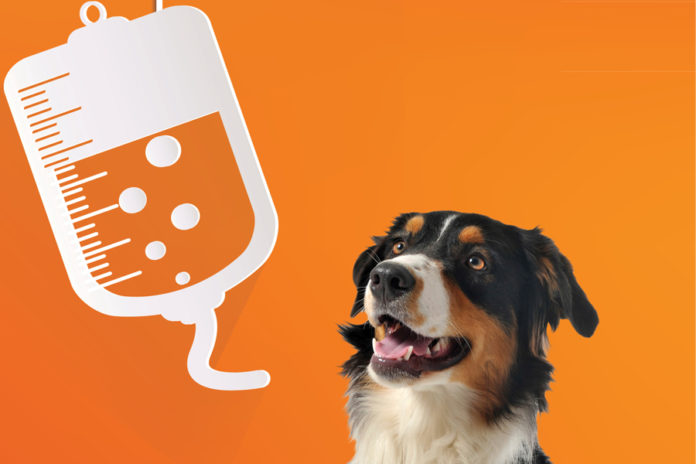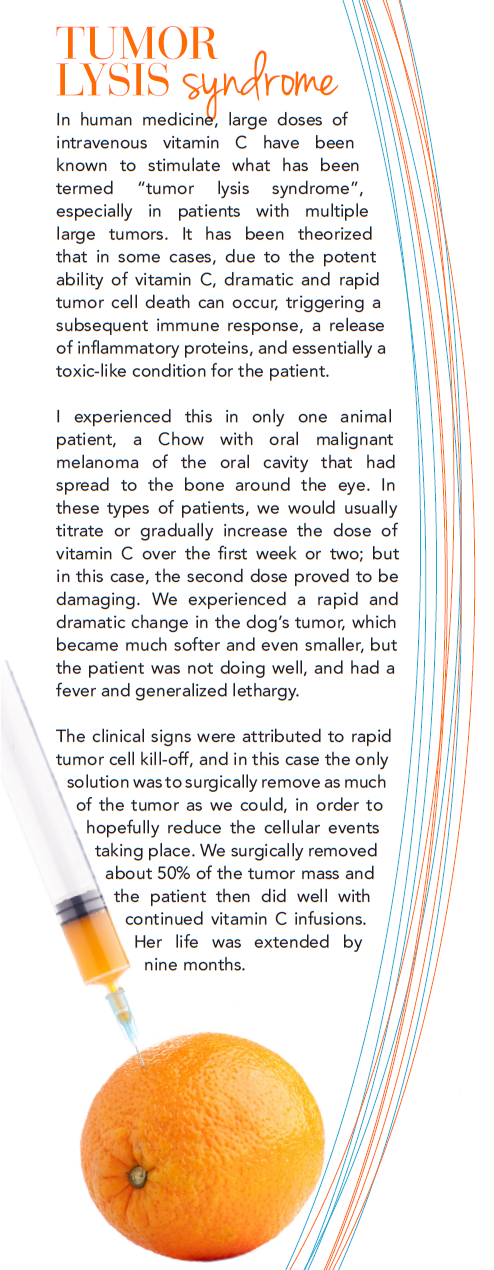High dose vitamin C therapy for pets – part 2

A look at why high doses of vitamin C are given intravenously, and how it can help with cancer and other health problems in dogs and cats.
In Part 1 of this article, we looked at the development and benefits of high dose vitamin C therapy. Now we’ll cover approaches to therapy and look at how it can help with cancer and other problems.
Why is the intravenous method used?
There are several reasons why high doses of vitamin C are given intravenously rather than orally.
- Higher levels of vitamin C are needed in the bloodstream to obtain desired results in the patient, and this can often only be achieved through intravenous administration. Our goal is to literally saturate the body with vitamin C, obtaining incredibly high blood levels of ascorbate for various purposes.
- With the oral route, the body is limited in its ability to absorb high amounts of vitamin C. It will only absorb a specified amount and the rest will be eliminated. According to Dr. Linus Pauling, this was termed “bowel tolerance”. As the patient absorbed what was needed orally, essentially saturating the body, the remaining amount would create an osmotic type of diarrhea. This “bowel tolerance” differed from patient to patient and condition to condition, with some patients able to take higher oral amounts before experiencing diarrhea, while others developing diarrhea on much lower amounts. In reality, this reflected the body’s “need” for vitamin C. If one patient can take 30 grams per day before developing diarrhea, while another develops diarrhea with only two grams, it likely signifies a higher level of vitamin C deficiency in the first patient, and thus a higher demand.
In the past, physicians and researchers such as Dr. Pauling, actually began to “name” conditions in terms of the amount of vitamin C needed to alleviate a condition in a particular patient – for example, the “10 gram cold”.
3. The intravenous route is chosen for various therapies with cancer patients and for other conditions. Through the intravenous route, we are able to bypass the GI tract, delivering ascorbic acid and other nutrients directly into the bloodstream, achieving high serum levels quite quickly. Many physicians in the past utilized other modes of administration, including intra-muscular injections, but the intravenous route is optimal as the intra-muscular shot can often be painful and thus limited in volume.
 In many alternative human practices, vitamin C is being used in doses ranging from ten to 100 grams, often twice weekly, given as a fluid infusion to the patient over a period of a couple of hours. Some practitioners combine the vitamin C with other micronutrients, while others use vitamin C alone, diluted in sterile water or saline.
In many alternative human practices, vitamin C is being used in doses ranging from ten to 100 grams, often twice weekly, given as a fluid infusion to the patient over a period of a couple of hours. Some practitioners combine the vitamin C with other micronutrients, while others use vitamin C alone, diluted in sterile water or saline.
Vitamin C therapy in the clinic
In 2006, our clinic invested in a device called the FRAS-4, which allowed us to measure free radical and antioxidant levels in our patients. We could visibly see how various health conditions ranging from trauma to surgery to cancer impacted the patient on a cellular level.
It was quite surprising to me, as a surgeon, to be able to see and evaluate the levels of free radical damage and depleted antioxidant reserves in surgical patients, especially geriatric animals undergoing routine procedures for tooth cleaning or minor mass removals. As a result, we began to routinely implement vitamin C infusions into our surgical protocols. I believe it helped our patients recover more quickly with fewer intra-op or post-op complications.
It was not uncommon for an owner to call our office the day after treatment and ask what we had given her pet, because he was running around the house and eating like a horse, when the day before he could barely get up.
Vitamin C infusions became a standard in our practice for many situations, ranging from traumas to surgeries to organ failure in older patients. Usually, we were already administering fluid therapy as part of our patient support, so we would simply add vitamin C to the infusion bag at set doses, depending on the current situation.
This therapy benefited patients with improved recovery times, improved healing and overall enhancement in health on many other levels. The vitamin C infusions were used alone or in combination with other therapies, including conventional antibiotics or corticosteroids as well as dietary and herbal therapy. No known negative interactions were noted; we believe the infusions actually helped create some synergism, enhancing the effects of other therapies.
Intravenous vitamin C and cancer
In our cancer patients, we had a few cases in which vitamin C therapy resulted in complete remission, while in others, we were able to dramatically extend survival time. In all patients, we saw huge improvements in energy, healing and appetite. It was not uncommon for an owner to call our office the day after treatment and ask what we had given her pet, because he was running around the house and eating like a horse, when the day before he could barely get up.
In many cases, we helped slow the progression of cancer, and the patient continued to thrive. I recall a Jack Russell terrier that presented for inoperable liver cancer; the owners had been told by an oncologist that nothing further could be offered. Through a combination of herbal and dietary therapy, and sporadic intravenous vitamin C therapy, this dog not only survived but thrived, living another three years and beyond my own retirement from private practice.
We were able to reduce the tumor size by 50%, though it was still present on repeat ultrasounds. The owners were always disappointed when I told them the tumor was still there, despite the fact it was so much smaller. They looked at cancer as a major illness, forgetting that their aged dog was running circles around them at home.
To me, the cancer was simply holding the dog back, creating deficiencies and drains on the body, but once corrected, this patient could actually “live” with the tumor. Many have noted that cancer is not a disease to be cured, but one to be managed — and high dose vitamin C therapy can play an effective part in achieving this goal, along with many others.



